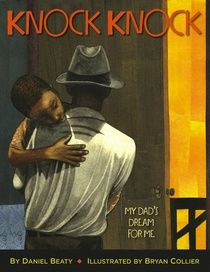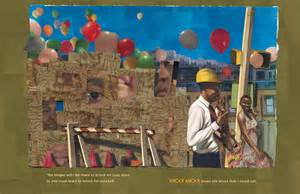
Above, please view the video of the author’s live performance of his version of Knock Knock: My Dad’s Dream for Me. Beaty’s performance is motivating, empowering, and arresting.
Author: Daniel Beaty
Illustrator: Bryan Collier
Age: Pre-k-Grade 6
Genre: Realistic Fiction
Summary: This is the story brings readers into an urban setting where a little boy lives. Every morning his father wakes him up playing a game as the father knocks on the door to find the little boy pretending he is asleep. The climax comes when the father doesn’t come one morning. The boy spends days waiting for his father to return until he finally writes him a letter and leaves it on his desk in hopes that his father will return home to find it. Eventually the father returns a letter which gives readers the idea that he did not die, but he never returns. The letter essentially tells the boy that the father’s life does not have to be the boy’s future; rather there are many possibilities that the boy can explore. Through the illustrations we can see that the boy eventually becomes a man and wears the father’s hat but in a bright yellow color. This could represent the memory of his father that he holds dearly with the bright future that he created for himself.
Use of book in a lesson: This story has a positive ending full of hope while holding the potential of touching the lives of so many children who grow up with an absent parent. While the story never tells the readers exactly where the father has gone, the author’s note gives us a clue that points towards incarceration. Since Beaty never tells readers where the father goes, the story remains universal and can be related into the lives of many children today. The vague location of the father also allows this story to be brought down to any aged child as any age could feel the emotional impact of the story without the harsh reality.
Since the message of this book is universal, I would most likely use this as a read-aloud for any class from grades K-6. As this story can be a mirror or a window book for any child, Knock Knock will certainly build community within the classroom. The way that I would incorporate this story would be different depending on the grade level. A generic direction would be to discuss the point of view of the narrator and how the story might be different if told from another perspective. For example, if this were used in a fifth grade classroom I may read this book as an introduction to a bigger literature lesson to explore point of view while addressing the Common Core State Standard for “describe how a narrator’s or speaker’s point of view influences how events are described” (CCSS.ELA-Literacy.RL.5.6) If this lesson needed to be geared down to for second graders, we could aim our discussion towards different speakers and their points of view as we see them in the story. When reading the letter aloud, the same voice would be used as the father’s dialogue since the letter is the father’s message to his son. This would address the Common Core State Standard for “Acknowledge differences in the points of view of characters, including by speaking in a different voice for each character when reading dialogue aloud” (CCSS.ELA-Literacy-RL.2.6).
In order to assess understanding I would facilitate a “talk show” in which the students take turns playing different roles of characters. The rest of the class would have opportunities to ask each “guest” on the show different questions to enhance meaning and comprehension of the story. In his article, “What’s New With Literature Circles and What’s the next Big Thing?” Harvey Daniels (2008) explains, “We now favor performance-oriented projects over more static types: readers theater, talk shows, tableaux, found poetry, song parodies, and the like” (p.5). Since the story would certainly change if told from any other person in the family, this lesson and method of assessment will allow students to gain a deeper understanding of the story as well as point of view.
References
Beaty, D. (2013). Knock knock: My dad’s dream for me. New York, NY: Little, Brown and Company.
Daniels, H. (2008). What’s new with literature circles and what’s the next big thing? (p. 1-8). Handout from the Walloon Institute.
National Governors Association Center for Best Practices & Council of Chief State School Officers. (2010). Common Core State Standards for English language arts and literacy in history/social studies, science, and technical subjects. Washington, DC: Authors.
